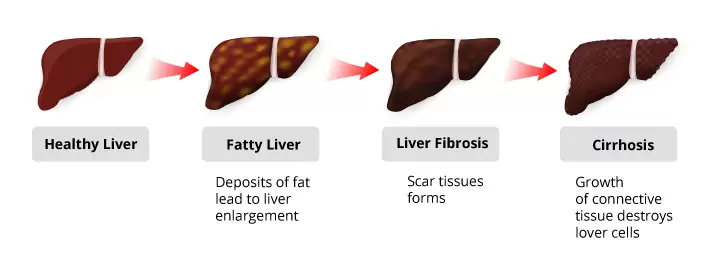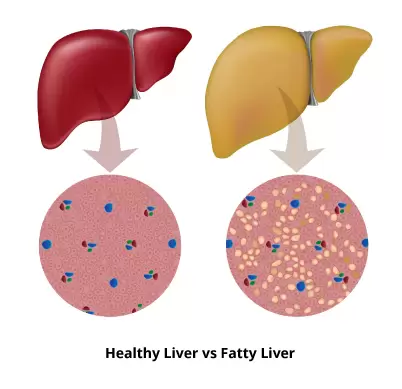
Types of Liver Diseases & Their Causes
Apr 23, 2018
Introduction
If liver is a superhero, Deadpool is the character that it would be! This is because, Deadpool’s healing super power is realistic – he can recover from almost any physical injury. This special attribute also possesses by our liver. In fact, liver is the only organ which can repair and regenerate itself. Even if you have donated a part of it to the patient in need, it will eventually regrow. Nevertheless, our liver can only stand to a certain limited degree as visualized in below diagram.

Stage 1: Fatty Liver
It is normal for a healthy liver to contain some fat as it is build up from phospholipids. However, if the fat weight is > 5% of the liver weight, it is considered as fatty liver. The two types of fatty liver are Alcoholic Fatty Liver Disease (ALD) and Non-Alcoholic Fatty Liver Disease (NAFLD).

Alcoholic Fatty Liver Disease (ALD)
A study had demonstrated, > 90% alcoholics develop fatty liver1. This is because, liver is the principal organ for alcohol metabolism. As facilitated by certain enzymes, alcohol will be converted into acetaldehyde, a poison which is highly toxic and carcinogenic2. Consequently, it will interrupt the liver from breaking down fats, thus causing them to be accumulated in the liver.
Non-Alcoholic Fatty Liver Disease (NAFLD)
NAFLD is more common in overweight and obese individuals.3 According to the Economist Intelligence Unit’s “Tackling Obesity in ASEAN” report, the prevalence of overweight and obesity in Malaysia was at 38% and 13% respectively.4 This marked, half of Malaysians are at risk!
The Silent Killer
Fatty liver is a silent killer because the progression of the disease is very gradual. Most patients experience little to no symptoms, leaving them unaware of their condition until it is critical. The patients will probably never know about it unless they have been diagnosed during tests which are carried out for any other reasons. Therefore, if you are overweight, adopt a healthy lifestyle and consult your doctor immediately! Early diagnosis is the key to reverse and treat liver damage.
Stage 2: Liver Fibrosis
Fatty liver can cause our liver to swell and if it is left untreated, the inflammation will start to cause the liver to scar – fibrosis. At this stage, healthy liver tissues are replaced by scar tissues thus the functional part of the liver is overburdened to fulfil the tasks of the entire organ. Fortunately, medication, supplementation, and healthy lifestyle may prevent its further progression. In fact, fibrosis is treatable and there is still a chance for the liver to heal and reverse to a healthy state.
Stage 3: Liver Cirrhosis
The further progression of fibrosis leads to permanent scarring – cirrhosis. At this stage, the blood flow through the liver are restricted and the liver can no longer heal itself. Occasionally, some people may experience extreme tiredness and an ache at the top right of the tummy (over the lower right side of the ribs). They can also get more obvious symptoms such as yellowing of the skin and the whites of the eyes (jaundice), itchy skin, and swelling in the legs, ankles, feet, or tummy. Once, when a person is diagnosed with cirrhosis, the treatment will focus on delaying the progression and treat any complications to keep the condition from getting worse. If cirrhosis is untreated, the liver will eventually fail and not be able to work at all, thus the only option will be liver transplant.
Livolin Forte
Livolin Forte is a health supplement providing Essential Phospholipids added with Vitamin B Complex and Vitamin E. It is a Triple Action Formula that acts as Regenerator • Detoxifier • Protector to keep our liver healthy.
Find out more: http://Biolife.2.vu/LivolinForte
References
- McCullough A. J. and O’Connor J. F. 1998. Alcoholic liver disease: proposed recommendations for the American College of Gastroenterology. American Journal of Gastroenterology, 93(11):2022-2036
- Edenberg H. J. 2007. The genetics of alcohol metabolism: role of alcohol dehydrogenase and aldehyde dehydrogenase variants. Alcohol Research & Health, 30(1):5-13
- Fabbrini E., Sullivan S., Klein S. 2010. Obesity and nonalcoholic fatty liver disease: biochemical, metabolic, and clinical implications. Hepatology, 51(2):679-689
- Farezza H. R. 2017. Malaysians most obese in region available at https://www.nst.com.my/news/nation/2017/06/246538/malaysians-most-obese-region
- Kozachok, M.M., Osyodlo G.V., Kuts, T.V., 2006. Role and place of essential phospholipids in treatment of chronic diffuse liver diseases. Modern Gastroenterology, 4(30): 73-79



